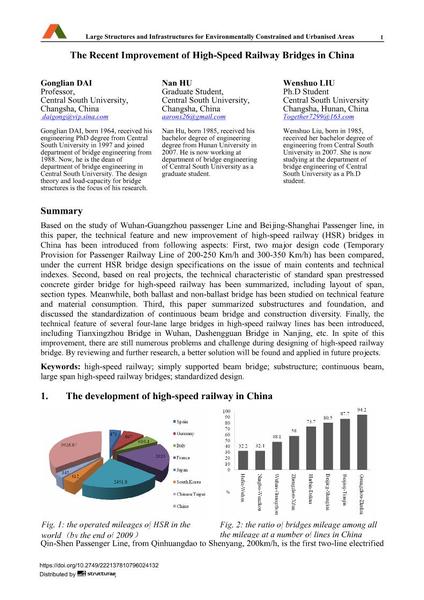The Recent Improvement of High-Speed Railway Bridges in China

|
|
|||||||||||
Bibliografische Angaben
| Autor(en): |
Gonglian Dai
Nan Hu Wenshuo Liu |
||||
|---|---|---|---|---|---|
| Medium: | Tagungsbeitrag | ||||
| Sprache(n): | Englisch | ||||
| Tagung: | IABSE Symposium: Large Structures and Infrastructures for Environmentally Constrained and Urbanised Areas, Venice, Italy, 22-24 September 2010 | ||||
| Veröffentlicht in: | IABSE Symposium Venice 2010 | ||||
|
|||||
| Seite(n): | 168-169 | ||||
| Anzahl der Seiten (im PDF): | 8 | ||||
| Jahr: | 2010 | ||||
| DOI: | 10.2749/222137810796024132 | ||||
| Abstrakt: |
Based on the study of Wuhan-Guangzhou passenger Line and Beijing-Shanghai Passenger line, in this paper, the technical feature and new improvement of high-speed railway (HSR) bridges in China has been introduced from following aspects: First, two major design code (Temporary Provision for Passenger Railway Line of 200-250 Km/h and 300-350 Km/h) has been compared, under the current HSR bridge design specifications on the issue of main contents and technical indexes. Second, based on real projects, the technical characteristic of standard span prestressed concrete girder bridge for high-speed railway has been summarized, including layout of span, section types. Meanwhile, both ballast and non-ballast bridge has been studied on technical feature and material consumption. Third, this paper summarized substructures and foundation, and discussed the standardization of continuous beam bridge and construction diversity. Finally, the technical feature of several four-lane large bridges in high-speed railway lines has been introduced, including Tianxingzhou Bridge in Wuhan, Dashengguan Bridge in Nanjing, etc. In spite of this improvement, there are still numerous problems and challenge during designing of high-speed railway bridge. By reviewing and further research, a better solution will be found and applied in future projects. |
||||
| Stichwörter: |
Unterbau
|
||||

